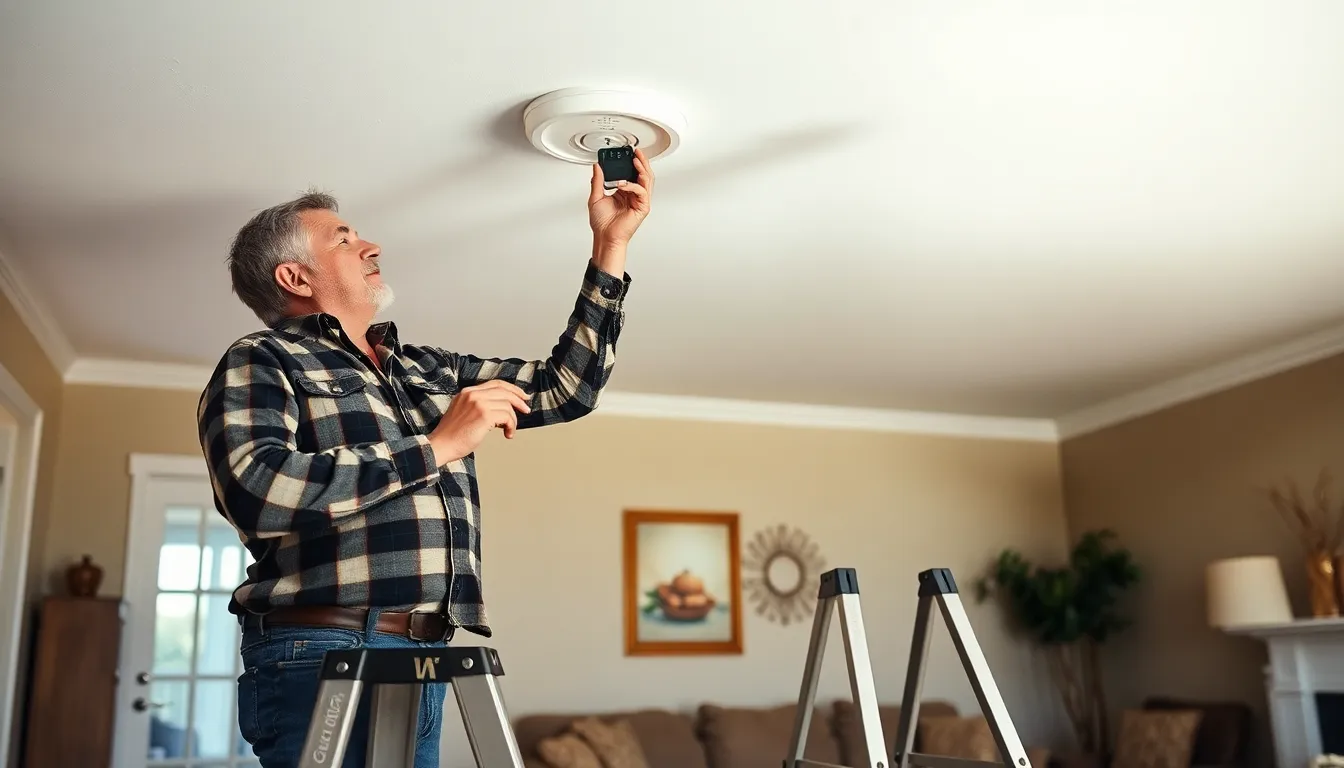Home safety inspections are essential for ensuring a secure living environment. They help identify potential hazards that could lead to accidents or injuries, protecting both residents and visitors. With the rising awareness of home safety, more homeowners are taking proactive steps to safeguard their spaces.
Conducting a thorough inspection not only highlights risks but also offers solutions to mitigate them. From checking smoke detectors to assessing structural integrity, each aspect plays a crucial role in maintaining a safe home. By prioritizing these inspections, individuals can create a haven that fosters peace of mind and well-being.
Table of Contents
ToggleUnderstanding Home Safety Inspection
Home safety inspection ensures a secure living environment by identifying and addressing potential hazards. These inspections play a critical role in protecting residents and promoting overall well-being.
Definition and Importance
A home safety inspection refers to a comprehensive evaluation of a residence to uncover risks that could result in accidents or injuries. Professional inspectors examine various elements, including structural integrity, fire safety systems, and environmental factors. These inspections are vital, as they help homeowners prioritize safety measures and ensure compliance with local regulations. Regular inspections lead to a safer home, reducing the likelihood of incidents and offering peace of mind to residents.
Common Hazards to Assess
Several common hazards require assessment during a home safety inspection:
- Fire Risks: Inspect smoke detectors, fire extinguishers, and escape routes to ensure adequate fire prevention and response.
- Electrical Issues: Check for exposed wires, overloaded circuits, and malfunctioning outlets that may pose fire or shock hazards.
- Structural Concerns: Assess the foundation, walls, and roofing for signs of damage or decay that could compromise safety.
- Slip and Fall Hazards: Evaluate flooring, stairways, and walkways for uneven surfaces or obstructions that increase the risk of accidents.
- Carbon Monoxide Exposure: Test carbon monoxide detectors and check appliances for safe operation to prevent poisoning risks.
- Toxic Substances: Identify potential sources of lead, asbestos, or mold that could negatively impact health.
By assessing these hazards, homeowners can take appropriate action to mitigate risks and enhance their living environment.
Preparing for a Home Safety Inspection

Preparing for a home safety inspection ensures a thorough evaluation of the property. Homeowners can streamline the process by gathering tools and creating a checklist.
Gathering Necessary Tools
Gathering the right tools facilitates an effective home safety inspection. Specific items include:
- Flashlight: A bright flashlight helps inspect dark areas.
- Multimeter: A multimeter checks electrical systems for faults.
- Smoke Detector Tester: This tool validates smoke detector functionality.
- Level: A level identifies uneven surfaces and potential structural issues.
- Ladder: A sturdy ladder allows access to high places for roof and chimney inspections.
- Measuring Tape: Measuring tape ensures proper dimensions are noted for safety modifications.
Creating a Checklist
Creating a checklist enhances the inspection process by focusing on key safety areas. Essential categories should encompass:
- Fire Safety: Check smoke detectors, fire extinguishers, and escape routes.
- Electrical Systems: Inspect outlets, circuit breakers, and wiring for damage.
- Structural Integrity: Examine foundations, walls, roofs, and ceilings for cracks and leaks.
- Slip and Fall Hazards: Identify and fix uneven surfaces, clutter, and poorly lit areas.
- Carbon Monoxide Detectors: Ensure detectors work and are installed in key locations.
- Toxic Substances: Assess for lead paint, mold, and other hazardous materials.
A detailed checklist promotes a thorough review, identifies potential issues, and reinforces a commitment to safety in the home.
Conducting the Home Safety Inspection
Executing a home safety inspection involves a systematic approach, ensuring all potential hazards receive attention. Homeowners should focus on both exterior and interior aspects for a comprehensive evaluation.
Exterior Inspection
Inspecting the exterior includes examining the following elements:
- Foundation: Look for cracks or signs of settling that could indicate structural issues.
- Roof: Assess shingles for missing or damaged areas and check gutters for clogs.
- Walkways and Driveways: Evaluate surfaces for cracks or unevenness that may pose trip hazards.
- Fences and Gates: Ensure they are intact and functioning properly to prevent unauthorized access.
- Lighting: Test outdoor lights for functionality to enhance safety during nighttime hours.
Interior Inspection
The interior inspection assesses essential safety features within the home:
- Smoke Detectors: Verify functionality and replace batteries as necessary.
- Carbon Monoxide Detectors: Ensure they are installed near sleeping areas and are operational.
- Electrical Systems: Check for exposed wires, tripped circuit breakers, and overloaded outlets.
- Stairs and Railings: Inspect for stability and ensure handrails are secure and within reach.
- Emergency Exits: Identify clear paths to exits and ensure they remain unobstructed.
This two-pronged approach to home safety inspection equips homeowners to identify and rectify potential hazards effectively.
Evaluating and Addressing Findings
Identifying safety issues during a home safety inspection requires careful evaluation and prompt action. Addressing these findings maximizes home security and enhances residents’ well-being.
Prioritizing Safety Issues
Assessing risks based on urgency ensures effective home safety management. Prioritizing safety issues involves:
- Immediate Threats: Identify hazards like exposed electrical wires, gas leaks, or malfunctioning smoke detectors that pose immediate dangers.
- Severe Structural Concerns: Evaluate structural issues, such as significant cracks in walls or foundations, which can have long-term consequences.
- Potential Health Hazards: Check for issues like mold, lead paint, and carbon monoxide leaks, which necessitate swift resolution.
- Moderate Risks: Address problems that may not be urgent but still require attention, such as loose railings or poor lighting in high-traffic areas.
Organizing findings by severity helps homeowners tackle the most critical issues first, ensuring enhanced safety.
Professional Help vs. DIY Solutions
Deciding between professional assistance and DIY solutions depends on the complexity of the findings.
- Professional Help: Complex issues like electrical, plumbing, or major structural repairs frequently require licensed professionals to ensure safety and compliance with regulations. Experts bring specialized knowledge and tools for effective resolutions.
- DIY Solutions: Simple, non-technical tasks, such as replacing batteries in smoke detectors, fixing minor leaks, or changing light bulbs, suit a DIY approach. Homeowners can effectively handle these situations with proper guidance and tools.
Homeowners should evaluate their comfort level and skill set against the identified safety issues to choose the appropriate route for resolution.
Benefits of Regular Home Safety Inspections
Regular home safety inspections offer numerous benefits that enhance the security and well-being of residents.
- Early Hazard Detection
Early detection of hazards prevents minor issues from becoming major problems. Identifying risks such as electrical malfunctions, structural weaknesses, or fire hazards allows for timely mitigation.
- Improved Safety Compliance
Regular inspections ensure compliance with local codes and regulations. Staying informed on safety requirements helps homeowners avoid fines and legal issues while maintaining a safe environment.
- Enhanced Peace of Mind
Homeowners gain peace of mind knowing their living space is safe. Regular inspections provide assurance that potential threats are recognized and addressed, promoting overall comfort.
- Increased Property Value
A well-maintained home retains its value. Regular inspections signal to potential buyers that the property has been cared for, making it more attractive in the real estate market.
- Lower Insurance Premiums
Some insurance providers offer discounts for homes with regular safety inspections. Homeowners can save on premiums while ensuring their property meets safety standards.
- Reduced Risk of Accidents
Assessing and addressing potential hazards minimizes the risk of accidents and injuries. Creating a safer environment enhances the quality of life for residents and visitors.
- Cost Savings on Repairs
Identifying issues early often leads to cost savings. Regular inspections help homeowners avoid expensive repairs by addressing problems before they escalate.
Overall, embracing regular home safety inspections contributes to a secure, compliant, and well-maintained living environment, fostering a safer community for everyone.
Home safety inspections play a vital role in ensuring a secure living environment. By identifying potential hazards and addressing them promptly, homeowners can significantly reduce the risk of accidents and injuries. Regular inspections not only enhance safety but also contribute to compliance with local regulations and can even improve property value.
Taking proactive steps towards home safety fosters peace of mind for residents and their families. Whether opting for professional help or tackling simpler tasks independently, prioritizing safety measures is essential. Embracing the practice of regular home safety inspections ultimately creates a safer community for everyone.







